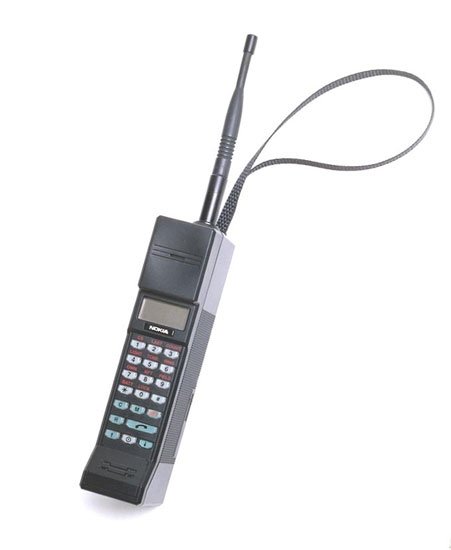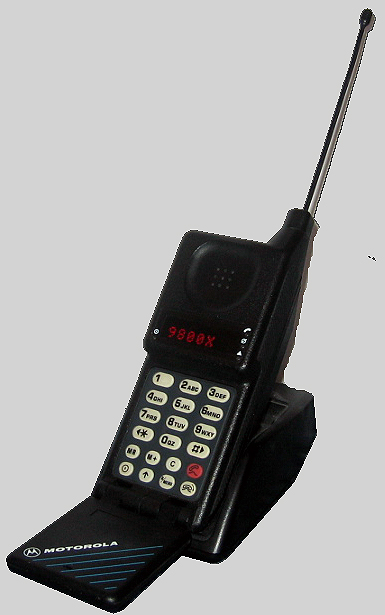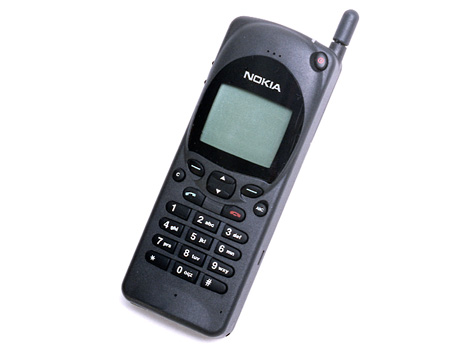31 Years Of Mobile Phones
The First Mobile Phone: Motorola DynaTAC 8000X (1984)
The first mobile phone was commercialized 32 years ago in 1984. The DynaTAC 8000X, designed by Motorola, was the first cell phone small enough to be carried in one hand. Although this was a significant leap for mobile phones, it was still a huge phone by today's standards. With modern phones Apple, HTC and Samsung fight to cut off every tenth of a millimeter and gram that they can, whereas the DynaTAC 8000X weighed 790 grams (1.74 pounds) and was 25 cm tall, not counting its external antenna. Worse, its autonomy was limited, and the battery only lasted for one hour during a call!
Its launch price was $3,995, about $7,220 after taking inflation into consideration. It was a gadget for the rich, which nonetheless began the cell phone revolution.
MORE: Best Smartphones
MORE: Smartphones In The News
MORE: All Smartphone Content
Nokia Mobira Senator (1982)
Motorolla's DynaTAC was a remarkable engineering feat, not only for its miniaturization, but also because it used AMPS—the first 1G cellular network in the U.S. AMPS was an analog system, and was one of the first cellular networks in the world. Japan developed an earlier 1G cellular network in 1979, and on the other side of the Atlantic, Finland established its 1G NMT (Nordisk Mobiltelefoni) in 1981.
Consumers seeking to take advantage of these earlier mobile networks used Nokia's first "mobile" phone that was released in 1982: the Nokia Mobira Senator. This phone was intended for use inside of a car and weighed 9.8 kg (21.6 pounds).
Nokia Cityman 900 (1987): Nokia Becomes Portable
Following the DynaTAC 8000X, the race to produce the smallest phone on the market began and continues to this day. Nokia responded in 1987 with the Cityman 900. This phone continued to use the 1G networks, and it weighed 760 grams. It could handle 50 minutes of talk time before the battery died, making it fairly similar to the DynaTAC 8000X. The two phones shared a similar appearance too, with the major difference being that the Cityman 900 was shorter, measuring just 18 cm high (excluding antenna). The phone was a significant success, and it helped to cement Nokia's position in the mobile phone market.
Motorola MicroTAC (1989)
Although the DynaTAC 8000X was a success, Motorola knew it needed a more travel friendly device to compete against the Cityman 900, which led to the release of the MicroTAC 9800X on April 25, 1989. Designed to fit inside a shirt pocket, it was the smallest and lightest mobile phone on the market when it launched. It was also the first phone to use the clamshell design, which helped to reduce its overall size. When the phone was opened, it still measured 23 cm tall, but it was significantly lighter, weighing just 300 grams. In order to keep the weight down, Motorola used a smaller battery, but at the cost of reducing talk time to roughly 30 minutes.
Get Tom's Hardware's best news and in-depth reviews, straight to your inbox.
The First GSM Phone: Orbitel 901 (1992)
In 1991 the GSM mobile network standard was finalized, and the first GSM network, named the Radiolinja network, was created in Finland. The GSM network technology delivered excellent audio quality and boosted network capacity relative to the 1G NMT network. The first phone to use this network was the Orbitel 901 released in 1992, which was relatively large and weighed 2 kg. As a result, it was also considered a car phone and not really a mobile phone.
Nokia 1011 (1992)
Nokia's next major mobile phone was the Nokia 1011; its first phone designed by Frank Nuovon. Released on November 10, 1992, the phone had several advantages over the Cityman 900, including height, weight, and features. The phone only measured 19.5 cm (including the antenna) and weighed 495 grams. The phone had a monochrome LCD display to access menus and to see the numbers as you dialed. It also used the GSM network standard, which gave it superior audio quality.
Hagenuk MT-2000 (1994): Internal Antenna & Games!
In 1994 the German manufacturer Hagenuk entered the world of mobile phones with the Hagenuk MT-2000. This phone was revolutionary because it was the first with an internal antenna instead of the telescope antenna used on all earlier phones. It operated on the German D-Netz 900 network, which used the GSM 900 standard.
The Hagenuk MT-2000 was also the first mobile phone to come with a game installed, a simple variation of Tetris, opening the door for gaming on phones.
Nokia 2110 (1994): The Musical Ringtone
Nokia introduced the 2110 in 1994. This phone followed the design of the 1011, but added the ability to send text messages to other phones, becoming the first phone capable of doing so. It also was the first phone to feature a musical ringtone. The Nokia ringtone was played over a simple speaker that was only capable of producing five different tones, but it forged a path to the more musical ringtones we have today.
The First Smartphone: IBM Simon (1994)
Contrary to popular belief, Apple did not invent the smartphone. Nor did Apple invent the touchscreen smartphone. Both of these technological breakthroughs can be attributed to IBM. Incredible as it may seem, the Simon Personal Communicator, which was created in 1994, had a 4.5-inch black and white display with a resolution of 293x160 and a resistive touchscreen interface. It was capable of making calls, sending faxes and responding to emails. It also had several other non-network oriented applications, including an address book, calendar, calculator and world clock. It even came with a stylus for hand writing notes that could then be stored on the device. The software interface included several elements that are common on phones today such as application icons and a virtual touchscreen keyboard. Similar to portable computers of the time, it also supported the use of PCMCIA cards to expand the feature set and install new applications. The entire system was driven by a 16MHz x86 processor.
All of these advanced features pushed the price of the phone up higher than most people were willing to pay, however, and IBM only sold 50,000 units before the company decided to end production. There wouldn't be another smartphone until Ericcson created one in 2000.
MORE: Best Smartphones
MORE: Smartphones In The News
MORE: All Smartphone Content
Motorola StarTAC 3000 (1996)
In 1996 Motorola released what would be known as one of the most iconic phones of the 1990s: the StarTAC 3000. At launch, it was the smallest mobile phone on the market by far. It weighed just 88 grams and updated the clamshell design by spreading hardware through both sections, instead of just a fold out microphone like on the MicroTAC. The phone was also one of the first to contain a vibrator.
The StarTAC originally used the aging AMPS network, but later models switched to GSM because of GSM's growing popularity and support. The phone was a huge success, selling over 60 million units.
Nokia Communicator (1996): A Smartphone Web Browser
While Motorola was attempting to innovate the mobile phone market by reducing the overall size and weight of its devices, Nokia opted to work towards adding new features and functionality to its phones. The Nokia Communicator 9000 was released in 1996 and was considered a smartphone, although its functionality was similar to what we would expect on modern day feature phones. It had a built-in browser, developed in-house by Nokia, that allowed users to surf the Web over the mobile network. The network performance was rather limited, with a maximum bandwidth of 9,600 bits/s.
The internal hardware was nearly identical to the Nokia 2110i, including a 24MHz Intel 80386 CPU, 8 Mb of RAM, and a 640x200 4.5-inch LCD display. The internal CPU and RAM are remarkably similar to what you would expect from a PC just one decade prior to the phone's release, showing a remarkable advancement in portable computing technology.
-
BadActor They have come a long way in a relatively short period of time. My first mobile phone was a Motorola bag phone with a large antennae. People would be amazed when you told them you were calling them from your car.Reply -
plasmastorm My 1st phone was an alcatel of some sort when I was about 14-15.Reply
1st phone you would recognize was the 7110 I got after that, loved that phone and would pay good money for the same shell with modern features. -
g-unit1111 My dad has had seriously nearly every single one of those dating back to the giant brick sized Motorola portable phone he got in like 1992 all the way to a Galaxy S6 which he has now.Reply -
chaosmassive I used to gaming on Nokia 3310Reply
you know, perfect score on space impact !
and snake at maximum speed !
-
AndrewJacksonZA You missed the first colour phone: the Siemens S10, launched in 1998.Reply
You included the first phone with a 1080p screen, but not the first phone with a 4k screen: the Sony Z5 Premium in 2015.
I got my first cellphone in 1997/1998. I think it was an Alcatel brick. I later inherited my Dad's Siemens S10. :-) -
10tacle My first "mobile" phone was a Motorola car version of the hand-held brick back in the late 1980s that my parents got me when I went off to college. Mobile service was spotty back then of course, even in relatively populated areas. And when I was roaming out of my service area, it was very expensive per minute....something insane like nearly a dollar a minute which in today's dollars is closer to two bucks a minute.Reply
Needless to say, we didn't yap much back then as even the contract plan cost per minute was something like $.25/minute on top of the monthly fee. In any event, it's always fun to reflect on all the old phones some of us older people have had over the decades. Even my retired four year old Android Motorola Razr Maxx smart phone can play older PC games, games that 10 years ago needed a pretty powerful build to run them on a 1600x1200 CRT monitor! -
Pat Flynn Awesome article guys, love seeing stuff like this! Historical mobile computing at its finest :)Reply -
g-unit1111 Reply17546961 said:My first "mobile" phone was a Motorola car version of the hand-held brick back in the late 1980s that my parents got me when I went off to college. Mobile service was spotty back then of course, even in relatively populated areas. And when I was roaming out of my service area, it was very expensive per minute....something insane like nearly a dollar a minute which in today's dollars is closer to two bucks a minute.
Needless to say, we didn't yap much back then as even the contract plan cost per minute was something like $.19/minute on top of the monthly fee. In any event, it's always fun to reflect on all the old phones some of us older people have had over the decades. Even my retired four year old Android Motorola Razr Maxx smart phone can play older PC games, games that 10 years ago needed a pretty powerful build to run them on a 1600x1200 CRT monitor!
My dad's car had one of these:
We thought it was state of the art back then. :lol: -
10tacle Reply17546990 said:My dad's car had one of these:
We thought it was state of the art back then. :lol:
LOL! That's exactly the Motorola design I had and mine was mounted in the center console like this, but it was after-market and not factory. Looks like Lexus got a contract with Motorola for a factory phone option. Awesome! If I remember correctly, the keys lit up in green.
Early adopter memories, heheheh.
-
g-unit1111 Reply17547042 said:17546990 said:My dad's car had one of these:
We thought it was state of the art back then. :lol:
LOL! That's exactly the Motorola design I had and mine was mounted in the center console like this, but it was after-market and not factory. Looks like Lexus got a contract with Motorola for a factory phone option. Awesome! If I remember correctly, the keys lit up in green.
Early adopter memories, heheheh.
It wasn't that exact one - that was just the first image I pulled on Google. My dad's was a Volvo and yeah the keys did light up green from what I remember. :lol:










